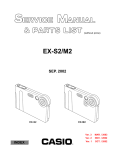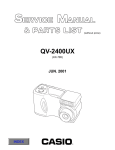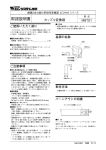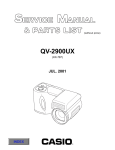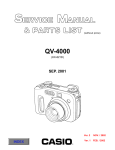Download Casio EX-S1/EX-M1 Specifications
Transcript
(without price) EX-S1/M1 JUN. 2002 EX-S1 EX-M1 INDEX R Ver. 2 Ver.1 Oct/ 2002 Jul/ 2002 CONTENTS SPECIFICATIONS ....................................................................................................................................... 1 TEST MODE ................................................................................................................................................ 4 PROGRAM VERSION UPGRADING .......................................................................................................... 5 1. How to confirm the program version ............................................................................................. 5 2. How to upgrade the program .......................................................................................................... 5 3. How to recover the program in case of the failure ....................................................................... 6 COLOR ADJUSTMENT .............................................................................................................................. 7 1. How to use USB ADJ Tool .............................................................................................................. 7 2. Lens Replacement ........................................................................................................................... 9 3. MAIN PCB Replacement ................................................................................................................. 9 4. VCOM DC adjustment .................................................................................................................... 10 5. Operation and Current consumption ........................................................................................... 10 DISASSEMBLY ......................................................................................................................................... 11 EXPLODED VIEW ..................................................................................................................................... 15 PARTS LIST .............................................................................................................................................. 16 PRINTED CIRCUIT BOARDS ................................................................................................................... 17 SCHEMATIC DIAGRAMS ......................................................................................................................... 20 SPECIFICATIONS Image Files Format Snapshots: JPEG (Exif Version 2.2); DCF (Design Rule for Camera File System)1.0 standard; DPOF compliant Movies: AVI (Motion JPEG) Audio: Recording Media WAV (EX-M1 only) 12MB built-in flash memory SD Memory Card MultiMedia Card Image Size Snapshots: 1600 x 1200pixels 1280 x 960pixels 640 x 480pixels Movies: 320 x 240pixels Approximate Memory Capacity and File sizes • Snapshots File Size Quality Approximate Image Built-in flash memory SD Memory Card* (pixels) 1600 x 1200 Fine File Size 1050KB 12MB 10 shots 64MB 53 shots (UXGA) Normal 710KB 15 shots 79 shots 1280 x 960 Economy Fine 370KB 680KB 30 shots 16 shots 154 shots 82 shots (SXGA) Normal 460KB 24 shots 126 shots 640 x 480 Economy Fine 250KB 190KB 42 shots 57 shots 220 shots 294 shots Normal 140KB 75 shots 386 shots Economy 90KB 120 shots 618 shots (VGA) • Movies (320 x 240 pixels) Data Size 150KB/second max. Recording Time One Movie: 30 seconds maximum Total Movie Time: 80 seconds maximum (built-in memory) 410 seconds maximum (SD 64MB memory card)* * Based on Matsushita Electric Industrial Co., Ltd. products. Capacity depends on card manufacturer. * To determine the number of images that can be stored on a memory card of a different capacity, multiply the capacities in the table by the appropriate value. Delete Single-file, all files (with protection) Effective Pixels 1.24 million Imaging Element 1.27-inch square pixel color CCD (Total pixels: 1.34 million) Lens/Focal Distance F2.5/f = 5.6mm (Equivalent to 37mm on a 35mm film camera.) Zoom 4X digital zoom Focusing Fixed focal point Approximate Focus Range (from lens surface) 1m to ∞ —1— Exposure Control Shutter Metering: Multi-pattern by imaging element Exposure: Program AE Exposure Compensation: –2EV to +2EV (in 1/3EV steps) CCD shutter, mechanical shutter 1/4 to 1/8000 second Aperture F2.5 fixed White Balance Automatic/fixed (4 modes) /Manual Self-timer 10 seconds Built-in Flash Flash Modes: Auto, Off, On, Red-eye reduction Approximate Flash Range: 1 meter to 2 meters Recording Functions Snapshot (with audio for EX-M1 only); self-timer; Night Scene; Movie (with audio for EX-M1 only); voice recording (EX-M1 only) * Audio is monaural Audio Recording Time Audio Snapshot: Approximately 30 seconds maximum per image (EX-M1 only) Voice Recording: Approximately 50 minutes with built-in memory After Recording: Approximately 30 seconds maximum per image Monitor Screen 1.6-inch TFT color LCD 84,960 pixels (354 x 240) Viewfinder Monitor screen and optical viewfinder Timekeeping Functions Built-in quartz digital clock Date and Time: Recorded with image data Auto Calendar: To 2049 Input/Output Terminals Cradle connector (EX-M1 connector is also used for connection of remote controller.) Speaker (EX-M1 only) 20mm round, monaural Audio Player Function Data Compression/Decompression: (EX-M1 Only) Sampling Frequencies: 32kHz, 44.1kHz, 48kHz Bit Rates: 32 to 210 kbps, VBR-compatible Play Mode: Normal, all track repeat, 1-track repeat Practical Maximum Headphone Output: 9mW + 9mW (16 Ω) Power Supply Power Requirements: MP3 (MPEG-1 Audio Layer-3) Rechargeable lithium ion battery (NP-20) x 1 Approximate Battery Life: Continuous Recording 80 minutes (480 shots) Continuous Playback (Continuous Snapshot Recording) 110 minutes Continuous Voice Recording* Continuous Audio Playback* 80 minutes 330 minutes The values noted above are approximate values until power fails, based on continuous recording with flash off, at normal temperature (25°C). The above does not guarantee that you will be able to achieve this level of operation. Low temperatures shorten battery life. Voice recording times are based on continuous recording, while audio playback times are based on continuous output (through headphones). * Voice recording and audio playback times apply to the EX-M1 only. Power Consumption DC 3.7V Approximately 3.0W —2— Dimensions EX-S1: 88(W) x 55(H) x 11.3(D) mm (3.5˝(W) x 2.2˝(H) x 0.4˝(D)) (excluding projections) EX-M1: 88(W) x 55(H) x 12.4(D) mm (3.5˝(W) x 2.2˝(H) x 0.5˝(D)) (excluding projections) Weight EX-S1: Approximately 85 g (3.0 oz) (excluding battery and accessories) EX-M1: Approximately 87 g (3.1 oz) (excluding battery and accessories) Bundled Accessories Rechargeable lithium ion battery (NP-20); USB Cradle; Special AC Adaptor; AC power cord; Strap; Special USB cable; Dummy Card; Connector Cover; LCD Remote Controller (bundled with EX-M1 only); Stereo Headphones (bundled with EX-M1 only); CD-ROM; Basic Reference; Rechargeable Lithium Ion Battery User’s Guide USB Cradle Input/Output Terminals Camera connector: USB port; AC adaptor terminal (DC IN 5.3V) Power Consumption: DC 5.3V Approximately 3.4W Dimensions: 95(W) x 55.5(H) x 39.5(D) mm (3.7˝(W) x 2.2˝(H) x 1.6˝(D)) (excluding projections) Weight: Approximately 56 g (2.0 oz) LCD Remote Controller Input/Output Terminals: Camera connector; headphones jack (ø3.5mm stereo mini jack) (Bundled with EX-M1 Only) Cord Length: Approximately 0.8m (31.5˝) Dimensions: 74.5(W) x 16(H) x 11(D) mm (2.9˝(W) x 0.6˝(H) x 0.4˝(D)) (excluding projections, excluding cradle) Weight: Approximately 28 g (1.0 oz) Power Supply • Use only the special NP-20 rechargeable lithium ion battery to power this camera. Use of any other type of battery is not supported. • This camera does not require a battery for the clock. The date and time settings of the camera are cleared whenever power supplied by both the battery and USB cradle is interrupted. Be sure to reconfigure these settings after power is interrupted. LCD Panel • The LCD panel is a product of the latest LCD manufacturing technology that provides a pixel yield of 99.99%. This means that less than 0.01% of the total pixels are defective (they do not turn on or always remain turned on). —3— TEST MODE Note: Do not perform the menu item unless explained here. (It may damage the internal data and camera becomes unusable.) Booting To boot the test mode While firmly pressing down both "MENU" and "SET" buttons, Turn the power on. Continue pressing "MENU" and "SET" until the MAIN MENU is displayed. 2 "POWER" button 1 "MENU" + "SET" buttons While holding the camera in a horizontal position, press the set button twice towards your "RIGHT" and then press "MENU" . EX-S1 (as of May 28, 2002) EX-M1 (as of May 28, 2002) ++ KX851 ++ PR : 02.05.26.00.56 LD : 1.06 MI : 41 ++ KX852 ++ PR : 02.05.26.00.56 LD : 1.06 MI : 41 "Right" button, "Right" button, "MENU" button 1 2 3 4 5 6 7 8 9 10 11 :VERSION INFO :VIDEO OUT :USB TCC TEST :TEST MENU :BEEP TEST : TA S K - 2 T E S T : R O M U P D AT E :ADJ TEST :REC-INFO :TEST SCRIPT : L A S T M E M O RY SET button MENU button —4— 1 2 3 4 5 6 7 8 9 :KEY CHECK :VOCM CHECK : M E M O RY C H E C K :COLOR CHECK :UGAIN CHECK :VGAIN CHECK :MESSAGE CHECK :LED CHECK :SW&JACK CHECK PROGRAM VERSION UPGRADING ■ Introduction Update the program using an SD card. Note: Make sure to use a fully charged battery. MAIN PCB becomes unusable if power down or an error occurs during program transmission. 1. How to confirm the program version ■ The program version can be confirmed in the test menu (refer to the previous page). ■ Turn the power on while pressing MENU button. The following program version also can be found. Check the LCD display. (Example) VER 1.00 (As of May 28. 2002) 2. How to update the firmware 1. Prepare the memory card which contains the software for upgrading firmware in the root directory. EX-S1: ex-s1.bin EX-M1: ex-m1.bin 2. Insert the above memory card into the camera, and set a fully charged battery in the camera. 3. While pressing MENU, press power switch. Keep pressing MENU until “PROGRAM UPDATE” appears in the camera LCD. The following appears. The version for the firmware update software in the memory card appears at the bottom. PROGRAM UPDATE YES NO NEW VERSION IS VER 1.00 4. Align the white cursor to “Yes” by the cross keys of and , and press SET. “NOW LOADING” appears in the LCD and the update starts. 5. ”COMPLETE” appears after the update finishes. 6. Remove the memory card after turning the power off once.Turn the power back on again while pressing MENU, and check the version. VER 1.00 VER1.00 appears this time. —5— 7. If the version is correct, turn the power off. 8. Finally, check the operation by recording, playing back and deleting an image. 3. How to recover the program in case of the failure 1. Prepare the following firmware restoration program and change its name to "mercury.bin". EX-S1 : kx851r.hbn EX-M1 : kx852r.hbn • Insert the SD card into the computer using the PC card adaptor. * Prepare the PC card adaptor for the SD card. • The computer recognises the SD card as a "REMOVABLE DISK". 2. 3. 4. 5. Copy "mercury.bin" to a root directory of an SD CARD. Insert it into the camera. Insert a fully charged battery into the camera. Turn the power on while pressing shutter release button. The operation LED changes in the following order; orange blinks, green blinks and green lights. 6. When green lights, the firmware restoration is finished. Remove the battery. 7. Turn the power on again while pressing both MENU and SET buttons. The firmware is successfully restored if the corresponding program version appears next to "PR:" of the test menu. 8. Finally, start the camera normally to check the operation by recording, playing back and deleting an image. —6— COLOR ADJUSTMENT ■ Introduction Make sure to perform the adjustment when replacing the lens unit or the MAIN PCB. The necessary software, driver and setting are explained in using USB ADJ Tool "adj331e.exe (Ver.1.1). Note that the tool, drivers etc. are available only for Windows. 1. How to use USB ADJ Tool 1-1. Prepare the necessary software, driver and DLL file. (1) Prepare the following three files. • Commom test driver for CASIO/PENTAX [testmode_pentax_casio] folder uusbd.dll uusbd.inf uusbd.sys • ADJ data read/write tool "adj331e.exe" • Commom DLL for USB test "uusbd.dll" (2) Place the commom test driver for CASIO/PENTAX in an appropriate place. (3) After downloading the common DLL for USB test, copy it to the same directory as that of the ADJ data read/write tool or under "c:windows/system. 1-2. Set the camera so that it recognizes the USB test mode. (1) Enter the test mode and then the initial test selection screen. Turn the power on while pressing both "MENU" and "SET". Press "RIGHT", "RIGHT" and "MENU. (2) Move the cursor to "3:USB TCC TEST" and press "SET". (3) Move the cursor to "1:USB TCC ON" and press "SET". (4) Press "MENU" button and leave the test mode. (5) This enables the camera to recognise the USB test mode flag. (6) When the USB test mode flag is ON, the test menu appears first when the camera power is turned on. * If the USB test mode flag should be OFF, set "2: USB TCC OFF" in the test menu. 1-3. Install the USB driver for the USB test mode in the computer. (The following is an example using the Windows Me.) (1) Prepare the USB driver for the USB test mode. (2) Turn the camera power on which is set in the USB test mode and let it enter the USB test mode as shown in 2.(the test menu appears right after the power is turned on). (3) Connect the camera in the above status to the computer by the USB cable. (4) "A wizard for the new hardware" appears. (5) Check "Designate the place for the driver (for users with sufficient knowledge)" and press "Next". (6) Check "Search for the optimum driver for the device (recommended)". (7) Check "Designate the place to search" , designate the place which contains "inf" file in the driver by pressing "Reference" button, and then press "Next" button. (8) When "Universal USB Driver (VMEM manufacturer's name)" appears upon message "Searching for the driver file for the following devices" , press "Next" button. (9) The file copy starts. (If a message "uusbd.Inf cannot be found" appears during the file copy, designate the same place as in the step 7). (10) Press "Complete" button. (11) Right-click "My computer", select "Property" and open "Device manager". If "Universal USB Driver (VMEM manufactur's name)" can be found in "USB device for UUSBD", the computer has successfully recognised the driver. (12) The test driver can be used for both CASIO/PENTAX. Installing the test driver into either one enables the other one to recognise it. —7— NOTE: How to uninstall the USB driver for the USB test mode • Connect the camera while in the USB test mode to the computer so that the computer recognises the camera. • Right-click "My computer", select "Property" and open "Device manager". • Select "USB device for UUSBD" , and then "Universal USB Driver (VMEM manufacturer's name)". • Press "Delete" button and delete the driver. • When using Windows98/98SE/Me, delete the following three files; (NOTE! Do NOT delete "usbd. inf" and "usbd.sys", whose names are much alike the following.) C:windows / inf / uusbd.inf C:windows / inf / other / KashiwanoUUSBD.inf C:windows / system32 / drivers / uusbd.sys • The driver has been successfully deleted. 1-4. Use the USB ADJ Tool (1) Prepare ADJ data read/write tool "adj331e.exe". (2) Copy the common DLL for USB test to the same directory as that of the ADJ data read/write tool "adj331e.exe" or under "c:windows / system". (3) Turn the camera power on which is set in the USB test mode and let it enter the USB test mode (the test menu appears right after the power is turned on). Connect the camera to the computer by the USB cable. (4) Boot "adj331e.exe." and use it as follows; • Read ADJ data from the camera. Press "read from the camera". • Write ADJ data into the camera. Press "write into the camera". • Save ADJ data which is read. Press "File" and "Save", and save it with an appropriate name. • Open ADJ data which is saved. Press "File" and "Open", and open the necessary file. —8— 2. Lens Replacement Make sure to perform the following procedure after replacing the lens. A foppy disk with the lens data is bundled in the spare parts of the lens unit. 1 Enter the TEST mode. 1.Turn the power on while pressing both "MENU" and "SET" buttons. 2.Press "RIGHT" button, "RIGHT" button and "MENU" button while the program version is displayed. 3.Select "3.USB TCC TEST". 4.Select "1. USB TCC ON". 5.Turn the power OFF. 2 Set the QV to the cradle and turn the power on and connect it to the computer by the USB cable. 3 Boot "adj331e.exe" . 4 Click "ADJ ALL READ", and display the data on the "adj331e.exe". 5 Find the No.321, "V-COM DC". 6 7 8 9 0 A B C 5 Write down this value(data). Replace the Lens unit. Perform the above 1 to 3 From "File/Open", open the bundled floppy disk, and transfer the data to 9 the "adj331e.exe". Find the No.321,"V-COM DC" Change the data to the former value.(Refer to 6). Click "WRITE" button of "ADJ ALL". After adjustment, change "1. USB TCC ON" to "2. USB TCC OFF". B 3. MAIN PCB Replacement Make sure to backup ADJ DATA before replacing the MAIN PCB. IMPORTANT NOTICE: The MAIN PCB is a common part for EX-S1 and EX-M1 as a spare part. After replacing MAIN PCB, firm up and system initialization should be required. Refer to the service bulletin QV-068. 1 Enter the TEST mode. 1. Turn the power on while pressing both "MENU" and "SET" buttons. 2. Press "RIGHT" button, "RIGHT" button and "MENU" button while the program version is displayed. 3. Select "3.USB TCC TEST". 4. Select "1. USB TCC ON". 5. Turn the power OFF. 2 Set the QV to the cradle and turn the power on and connect it to the PC by the USB cable. 3 Boot "adj331e.exe" . 4 Click "ADJ ALL READ", and display the information on the computer screen. —9— 5 Save the information in the computer. 6 Replace the MAIN PCB. 7 Perform the above 1 to 3 after replacing the MAIN PCB without any problem. 8 Open the file which is saved above. 9 Click "WRITE" button of "ADJ ALL". 0 After adjustment, change "1. USB TCC ON" to "2. USB TCC OFF". 5 8 9 4 4. Operation and Current consumption 1. Operation check 1 Unti-shock, Battery operations 2 Switch, buttons operations 3 SD CARD insersion/eject operation, battery cover open/close operation 4 Resolution and color repeatability check 5 AE operation 6 Charging and cradle connection (USB function etc.) check 7 Appearance check 8 Buzzer check (EX-S1 only) 9 Recording with a microphone, speaker and earphone sound production, and remote controller operation check (EX-M1 only) 2. Current consumption test Current consumption (Vcc1 = 3.60 ± 0.05 [V]) • Make sure that current consumption is less than 450 mA in PLAY mode. • Make sure that current consumption is less than 530 mA in REC mode. • Make sure that current consumption is less than 2mA when power is turned OFF. — 10 — DISASSEMBLY NOTE : Here EX-M1 is used. 1. Remove the CARD, BATTERY and the JACK COVER. 2. Remove five screws. Screws Screws Screw 3. Remove the REAR CASE ASSY. — 11 — 4. Removing the LCD ASSY 1 Remove the hook from the MAIN PCB and slide the LCD ASSY. 2 Remove the CONNECTOR. 3 Remove the LCD ASSY. 1 2 3 Connector NOTE: Fix the FPC to the CONNECTOR tightly when assembling. 5. Remove the FPC from the CONNECTOR and then remove the SW UNIT. Connector — 12 — 6. Removing the SUB PCB ASSY 1 Unsolder the five lead wires. 2 Remove the hook and then the SUB PCB ASSY. The SUB PCB is connected to the MAIN PCB by the CONNECTOR. Note in assembling *1 Position these four lead wires in the space between the MAIN PCB and the SUB PCB. *2 Make sure that this lead wire does not touch the battery spring. × 2 *1 × 2 *1 1 × 1 *2 2 7. Removing the STROBE UNIT (NOTE: The STROBE UNIT does not need be discharged.) 1 Remove the STROBE PLATE. 2 Remove the CONNECTOR and then the STROBE UNIT. 1 Remove the CONNECTOR by twisting it toward the right by a pliers. NOTE: Pinch the reinforced part so that the CONNECTOR is not hurt. Use a pliers when assembling also. 2 — 13 — 8. Removing the LENS UNIT 1 Remove the CONNECTOR. 2 Remove the LENS UNIT while taking care of the hook. Hook 9. Remove the MAIN PCB. 10. Remove the microphone (EX-M1 only). — 14 — 22 14 13 7 S1 19 4 2 10 20 11 S1 21 — 15 — 1 12 18 8 S1 15 5 6 17 16 Dumy Card/ SD Card EXPLODED VIEW 3 9 PARTS PRICE LIST EX-S1/M1 N Parts Code Item Parts Name Specification QTY EX-S1 EX-M1 Price Code R N 1 10085205 LENS UNIT RJK503328*001V01TK 1 1 DI B N 2 10085206 ASSY / FRONT CASE RJK502949*001V01TK 1 0 CN C N 2 10084967 ASSY / FRONT CASE RJK502953*001V01TK 0 1 CQ C N 3 10085208 ASSY / REAR CASE RJK502892*001V01TK 1 0 CH C N 3 10084968 ASSY / REAR CASE RJK502952*001V01TK 0 1 CF C N 4 10085223 ASSY / BATTERY COVER RJK502891*001V01TK 1 1 AN B N 5 10085225 LCD ASSY RJK502889*001V01TK 1 1 DB A N 6 10085226 PCB ASSY / S RJK502890*001V01TK 1 0 CH A N 6 10084969 PCB ASSY / S RJK502954*001V01TK 0 1 CY A N 7 10087571 PCB ASSY / MAIN RJK503309*001V01TK 1 1 DY A N 8 10083508 CAP / CONNECTOR A-K851 RJK503051-001V01 1 1 AB X N 9 10081376 GRIP A-K851 RJK502704-001V01 1 1 AF X N 10 10083019 ADHESIVE TAPE / GRIP-K851 RJK502825-001V01 1 1 AA X N 11 10084818 CONDENSER MIKE EML6253X3200G 0 1 AP C N 12 10084753 SHUTTER UNIT AKE-1340 1 1 BH B N 13 10084761 STROBE UNIT EFN-CAQ33 1 1 CO B N 14 10081391 PLATE / STROBE A-K851 RJK502815-001V01 1 1 AA X N 15 10084760 SW UNIT UBF013M01A 1 1 BG B N 16 10081380 KEY / CURSOR A-K851 RJK502714-001V01 1 0 AE C N 16 10081395 KEY / CURSOR A-K852 RJK502832-001V01 0 1 AE C N 17 10081358 SPRING / BATTERY RJK502706-001V01 3 3 AB X N 18 10081379 BUTTON / MENU A-K851 RJK502713-001V01 1 0 AE C N 18 10081397 BUTTON / MENU A-K852 RJK502835-001V01 0 1 AE C N 19 10081373 KNOB / SW A-K851 RJK502697-001V01 1 0 AF X N 19 10081375 KNOB / SW A-K852 RJK502701-001V01 0 1 AF X N 20 10081374 SW BASE A-K851 RJK502699-001V01 1 0 AF X N 20 10081396 SW BASE A-K852 RJK502834-001V01 0 1 AF X N 21 10081356 PLATE / SW A-K851 RJK502700-001V01 1 0 AA X N 21 10081371 PLATE / SW A-K852 RJK502819-001V01 0 1 AA X N S1 10081372 SCREW A-K851 RJK502836-001V01 5 5 AA X N C139 EECENOF204R 1 1 AL C N FU800 10057715 FUSE KMD13 1 1 AB B N SW801 10085453 SWITCH SKRKAAE010 1 1 AD C N SW803 10085455 SWITCH SSSS810301 1 1 AC C MK11-2443 1 1 CP B Remarks PCB ASSY / MAIN 10085385 CONDENSER / BACKUP PCB S-UNIT ACCESSORY N 22 10085901 BATTERY / LITHIUM-ION N - 10085907 CD-ROM CK851DCA01R 1 1 AI C N - 10085906 ADAPTOR / AC AD-C50G-WW 1 1 BT C EXCEPT USA N - 10085887 ADAPTOR / AC AD-C50J-WW 1 1 BR C USA *1 - 10006299 CORD / AC CBL-K799-AC-JU 1 1 AO C For USA - 10006300 CORD / AC CBL-K799-AC-EU 1 1 AR C For EURO - 10006301 CORD / AC CBL-K799-AC-UK 1 1 BR C For UK N N - 10085898 USB CABLE UC-K851-CL10 1 1 AO C N - 10085899 CRADLE WAU0990-000AL 1 1 CN C N - 10085911 HEADPHONE HP-K852-SR 0 1 AW C N N - - 10085912 REMOTE CONTROLLER 10085897 STRAP 10091600 DUMY CARD R66-5819 ST-K851-A RJK503523-001V01 0 1 1 1 1 1 CO AE AB C X C *1 : AC PLUG is built-in. - 16 - PRINTED CIRCUIT BOARDS MAIN PCB TOP VIEW — 17 — MAIN PCB BOTTOM VIEW — 18 — SUB PCB TOP VIEW BOTTOM VIEW — 19 — SCHEMATIC DIAGRAMS MAIN PCB — 20 — SUB PCB (EX-S1 only) — 21 — SUB PCB (EX-M1 only) — 22 — Ver.1 : (1) The button to be pushed in the test mode has been changed. (page 4 and 9) (2) The following items were changed. · PARTS LIST (page 16) Ver. 2 : Correction of page 4, 5, 6, 7, 8, 9, 10 and 16. CASIO TECHNO CO.,LTD. Overseas Service Division Nishi-Shinjuku Kimuraya Bldg. 1F 5-25, Nishi-Shinjuku 7-Chome Shinjuku-ku, Tokyo 160-0023, Japan

























